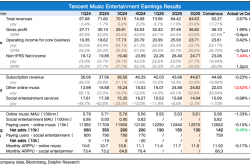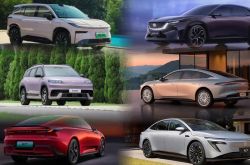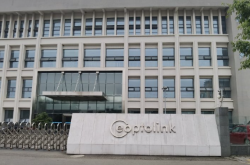AI Chip World | Technology Innovation | Two Top Players in the Autonomous Driving Sector Go Public on the Same Day, Ushering in High-Level Competition
![]() 11/13 2025
11/13 2025
![]() 507
507
Foreword: On November 6, 2025, the bell at the Hong Kong Stock Exchange rang twice. Pony.ai and WeRide, the two companies hailed as the [China's L4 Autonomous Driving Powerhouses], completed their simultaneous listing on the Hong Kong Stock Exchange. The former, with a fundraising amount of 7.7 billion Hong Kong dollars after the greenshoe option, became the largest IPO in the global autonomous driving sector in 2025; the latter secured the title of the [First Robotaxi Stock on the Hong Kong Stock Exchange], raising 2.39 billion Hong Kong dollars. However, this highly anticipated [double celebration] ended with an unexpected twist, as the share prices of both companies fell below their issue prices after opening, with declines exceeding 10%. The abnormal movement of the share prices serves as a mirror, reflecting the true situation of the autonomous driving industry: the industry has transitioned from the laboratory to the eve of commercialization, yet the real constraints of high investment and low profitability remain unbroken.
Author | Fang Wensan
Image Source | Network

Pony.ai: A Deep Diver in the Pure L4 Route
Pony.ai has always adhered to the pure L4 route, refusing to compromise with L2+ assisted driving.
Co-founder and CTO Lou Tiancheng once used a vivid metaphor to explain its strategy: [L2 and L4 are like football and basketball. Top football players rarely become top basketball players because the technical logic is completely different.]
This commitment is reflected in its business layout, as Pony.ai focuses on the dual mainlines of Robotaxi + Robotruck, forming a dual-engine drive of passenger and commercial vehicles.
In the Robotaxi sector, it is the only company to have obtained fully driverless operation permits in the four first-tier cities of Beijing, Shanghai, Guangzhou, and Shenzhen. As of the first half of 2025, its fleet size exceeded 720 vehicles, with cumulative real-world road tests exceeding 55 million kilometers.
Among them, the fully driverless mileage exceeded 10 million kilometers, and it has already achieved 7×24-hour fully driverless services in Guangzhou and Shenzhen, with Beijing also initiating all-weather road tests.
In April 2025, Pony.ai launched the seventh-generation Robotaxi model jointly developed with Toyota, BAIC, and GAC, marking a key breakthrough in its commercialization.
The new generation of models has achieved automotive-grade mass production, with the cost of the autonomous driving suite decreasing by 70% compared to the previous generation, including an 80% decrease in the cost of the computing unit, a 68% decrease in the cost of solid-state lidar, laying a cost foundation for large-scale deployment.
Financial data shows that in the second quarter of 2025, Pony.ai's total revenue was 154 million yuan, a year-on-year increase of 75.9%, with Robotaxi passenger fare revenue surging by over 300% year-on-year, demonstrating initial commercialization results.
In the Robotruck sector, Pony.ai has also made rapid progress, with cumulative freight mileage exceeding 107 billion freight ton-kilometers. In 2024, the revenue from this business accounted for 53.8%, becoming an important revenue pillar for the company.
In terms of overseas layout (translated as 'global expansion'), Pony.ai adopts a precise breakthrough strategy, establishing R&D centers in Silicon Valley and Luxembourg, with business covering eight countries including South Korea, Saudi Arabia, and the United Arab Emirates, holding testing permits in six countries, and planning to achieve fully driverless commercialization overseas by 2026.
WeRide: A Global Player with a Full-Scenario Layout
Unlike Pony.ai's vertical deep dive, WeRide has chosen a platform-based + multi-scenario expansion path, following a commercial realism route of walking on [L4 + L2+] legs.
Founder Han Xu's strategic thinking is clear: before the large-scale commercialization of Robotaxi matures, research and development costs can be shared through multi-scenario landings, quickly realizing commercial value.
Based on its self-developed WeRide One universal autonomous driving platform, WeRide has constructed a five-product matrix covering Robotaxi, Robobus, Robosweeper, Robovan, and ADAS.
This layout has enabled it to quickly achieve commercialization in multiple scenarios: in 2024, revenue from unmanned minibuses accounted for 22%, revenue from unmanned sanitation vehicles accounted for 15%, and revenue from technical services accounted for 45%, while revenue from Robotaxi accounted for less than 15%.
2025 has become a breakthrough year for WeRide's Robotaxi business, with revenue from this business reaching 45.9 million yuan in the second quarter, a year-on-year increase of 836.7%, accounting for 36.1% of total revenue.
Its core advantage lies in its global layout. As the only company in the world whose products hold autonomous driving licenses in seven countries including China, the United Arab Emirates, Singapore, and France, WeRide's business has covered 11 countries and more than 30 cities.
It operates the largest commercialized Robotaxi fleet outside of China and the United States with Uber in the Middle East, and is the only company in Europe to have achieved commercial deployment of L4 fleets, maintaining a lead of at least one and a half years over its peers.
In terms of fleet size, WeRide's L4 autonomous driving fleet exceeds 1,500 vehicles, including over 700 Robotaxis, with plans to deploy tens of thousands of vehicles before 2030.
In terms of technology export, its ADAS solution jointly developed with Bosch has reached SOP and will enter mass production in 2025, becoming an important profit growth point.
Behind the Listings: From Money-Burning Competition to Value Return
Pony.ai and WeRide's decision to quickly return to Hong Kong for listing less than a year after their U.S. listings reflects profound changes in the autonomous driving industry.
In the past, the industry competed on technical parameters and financing capabilities, with companies able to attract capital by simply showcasing the number of lidars and algorithm accuracy rates.
Today, the logic of capital valuation has been completely refactor (translated as 'restructured'), with commercialization progress, cost control effectiveness, and cash flow health becoming the core assessment indicators.
The financial data of the two companies reveals the urgency of going public for financing.
In 2024, Pony.ai incurred a loss of nearly 2 billion yuan, while WeRide incurred a loss of 2.5 billion yuan.
In the first half of 2025, the former's net loss was 681 million yuan, a year-on-year increase of 75.07%; the latter's net loss was 792 million yuan, a year-on-year decrease of 10.32%.
As of June 2025, Pony.ai had 608 million U.S. dollars in cash and short-term investments, while WeRide had 3.836 billion yuan in cash and equivalents, which can support short-term operations but still require continuous [capital infusion] in the face of large-scale expansion and R&D investments.
In terms of fundraising usage, both companies will allocate core funds to commercialization landings.
Pony.ai will use 50% of the funds raised for large-scale commercialization of L4 technology and 30% for fleet expansion; WeRide will use 40% for technology R&D and 40% for fleet mass production and operations.
The capital market's differentiated judgments on their business models indicate that Pony.ai's dual-mainline + local deep dive model offers more stable cash flows, while WeRide's multi-scenario + global layout requires larger upfront investments and has a longer return cycle.
The Truth Behind the Breaks: Capital's Rational Assessment of Profitability Prospects
The breaks on the first day of listing for the two powerhouses are not a sign of industry decline but an inevitable result of capital returning to rationality.
Currently, no Robotaxi company in the world has achieved large-scale profitability, and the industry is still in the stage of [burning money for scale].
Data shows that on average, for every 1 yuan of revenue generated, leading Robotaxi companies need to invest 3.8 yuan in R&D expenses. The huge gap between costs and benefits keeps capital vigilant against valuation bubbles.
High costs are the core pain point. In 2021, the cost of an L4 autonomous driving system was as high as 500,000 yuan per vehicle, 33 times the operating cost of a traditional taxi.
Although Pony.ai and WeRide have significantly reduced costs through automotive-grade mass production and supply chain integration, there is still a considerable gap to achieve cost parity with human drivers.
The unclear profitability path also keeps investors on the sidelines. Currently, the core revenues of both companies do not come from Robotaxi operations.
Pony.ai relies on Robotruck services and technology licensing, which accounted for 89.9% in 2024; WeRide relies on hardware sales and technical services, with product revenue accounting for 24.3% and service revenue accounting for 75.7% in 2024.
Robotaxi, as the core business, is still in the stage of user education + scenario validation and has not yet formed a sustainable profitability model.
In addition, the intensifying competition in the industry has also heightened capital's cautious sentiment.
Besides Pony.ai and WeRide, Baidu Apollo Go has achieved a cumulative global service volume of over 17 million orders, with weekly order volume exceeding 250,000;
Didi plans to deploy over 1,000 Robotaxis in 2025 and achieve a scale of one million units by 2030;
Tesla's Cybercab prototype vehicle has made its debut, building a technological barrier with over 10 billion miles of real-world road data;
XPeng Motors has also announced that it will launch trial operations of L4 Robotaxi in 2026.
With numerous players in the track (translated as 'sector'), the market presents an [oversupply] situation, making capital cautious about the breakthrough prospects of individual companies.
The Next Five Years: Who Can Survive the Commercialization Deadline
Frost & Sullivan predicts that by 2030, the market size of Robotaxi services in China will reach 39 billion U.S. dollars, accounting for more than half of the global market share.
Burnside Consulting points out that by 2030, the global market size of L4 and above autonomous driving will reach 1,464 billion U.S. dollars, with a compound annual growth rate of 238%.
Currently, Pony.ai has reduced the cost of the seventh-generation Robotaxi autonomous driving suite to 30% of the previous generation through strategies such as automotive-grade mass production, supply chain integration, and self-developed core components.
WeRide, on the other hand, shares R&D costs through technology export + scenario focus, exporting ADAS technology to automakers while focusing on closed-scenario operations to reduce testing costs.
The industry consensus is that only by reducing the cost of autonomous driving suites to below 100,000 yuan and achieving cost parity with human drivers can Robotaxi become competitive in the market.
Whoever can first break through this bottleneck will take the initiative in large-scale deployment.
In the past, the commercialization of Robotaxi mostly stayed at the level of single-point pilots and failed to form a sustainable model.
Today, the market requires companies to find core scenarios that are [profitable and replicable] to achieve the transition from pilot to large-scale operations.
Pony.ai chooses to deeply cultivate first-tier cities such as Beijing, Shanghai, Guangzhou, and Shenzhen, focusing on high-frequency scenarios such as urban main roads and transportation hubs, and improving order density through refined operations.
Its App has registered over 500,000 users, with each fully driverless Robotaxi receiving an average of over 15 orders per day.
WeRide, on the other hand, seizes opportunities in policy-lenient and market-blank regions such as the Middle East and Southeast Asia through its global layout, cooperating with ride-hailing platforms like Uber and Grab to build a [technology + traffic] closed loop and quickly increase market penetration.
In 2024, Pony.ai's R&D expenditure accounted for 320.1%, while WeRide's R&D expenditure accounted for 302.2%, both far exceeding traditional automakers.
Before commercialization is achieved, a company's ability to raise funds and manage cash flows directly determines whether it can [survive until the day of profitability].
Conclusion:
The industry has bid farewell to the [golden age] of capital pursuit and entered a [real combat] stage focused on commercialization landings and cost control.
In the coming years, the industry will see polarization, with leading companies seizing core markets with their technological, financial, and ecological advantages, while smaller players may be acquired or focus on niche scenarios.
Ultimately, the companies that can survive and achieve profitability will be those that can find a balance between costs, landings, and cash flows.
This dual listing spectacle is not only the prelude to large-scale competition in the industry but also a milestone in the transition of autonomous driving from concept hype to value verification.
Partial reference sources: WeRide: [First Robotaxi Stock on the Hong Kong Stock Exchange! WeRide Officially Listed on the Hong Kong Stock Exchange], CV Source: [Just Now, the Largest IPO in the Global Autonomous Driving Sector in 2025 Was Born], Intelligent Reconstruction: [Autonomous Driving Sector, Two Super IPOs Arrived on the Same Day], Top Tech: [Robotaxi Powerhouses Race, Pony.ai and WeRide Listed on the Hong Kong Stock Exchange on the Same Day, Profitability Turnaround Still a Long Way to Go], Tech Insights: [Double Giants Break, Robotaxi Enters a New Stage], Lujiu Business Review: [WeRide and Pony.ai [Argue] Before IPO, Who is Currying Favor with Investors?], Tingchao TI: [[Prickly] Pony.ai, Defiant WeRide]






